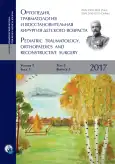Planning corrective osteotomy of the femoral bone using three-dimensional modeling. Part II
- Authors: Baskov V.E.1, Baindurashvili A.G.1, Filippova A.V.1, Barsukov D.B.1, Krasnov A.I.1, Pozdnikin I.Y.1, Bortulev P.I.1
-
Affiliations:
- The Turner Scientific Research Institute for Children’s Orthopedics
- Issue: Vol 5, No 3 (2017)
- Pages: 74-79
- Section: Articles
- URL: https://bakhtiniada.ru/turner/article/view/7072
- DOI: https://doi.org/10.17816/PTORS5374-79
- ID: 7072
Cite item
Abstract
Introduction. Three-dimensional (3D) modeling and prototyping are increasingly being used in various branches of surgery for planning and performing surgical interventions. In orthopedics, this technology was first used in 1990 for performing knee-joint surgery. This was followed by the development of protocols for creating and applying individual patterns for navigation in the surgical interventions for various bones.
Aim. The study aimed to develop a new 3D method for planning and performing corrective osteotomy of the femoral bone using an individual pattern and to identify the advantages of the proposed method in comparison with the standard method of planning and performing surgical intervention.
Materials and methods. A new method for planning and performing corrective osteotomy of the femoral bone in children with various pathologies of the hip joint is presented. The outcomes of planning and performing corrective osteotomy of the femoral bone in 27 patients aged 5 to 18 years (32 hip joints) with congenital and acquired deformity of the femoral bone were analyzed.
Conclusion. The use of computer 3D modeling for planning and implementing corrective interventions on the femoral bone improves the treatment results owing to an almost perfect performance accuracy achieved by the minimization of possible human errors reduction in the surgery duration; and reduction in the radiation exposure for the patient.
Full Text
##article.viewOnOriginalSite##About the authors
Vladimir E. Baskov
The Turner Scientific Research Institute for Children’s Orthopedics
Author for correspondence.
Email: dr.baskov@mail.ru
MD, PhD, head of the department of hip pathology
Russian Federation, 64, Parkovaya str., Saint-Petersburg, Pushkin, 196603Alexei G. Baindurashvili
The Turner Scientific Research Institute for Children’s Orthopedics
Email: turner01@mail.ru
MD, PhD, professor, member of RAS, honored doctor of the Russian Federation, Director of The Turner Scientific and Research Institute for Children’s Orthopedics
Russian Federation, 64, Parkovaya str., Saint-Petersburg, Pushkin, 196603Anastasia V. Filippova
The Turner Scientific Research Institute for Children’s Orthopedics
Email: mmers@list.ru
MD, research associate of the scientific-organizational department
Russian Federation, 64, Parkovaya str., Saint-Petersburg, Pushkin, 196603Dmitry B. Barsukov
The Turner Scientific Research Institute for Children’s Orthopedics
Email: dbbarsukov@gmail.com
MD, PhD, senior research associate of the department of hip pathology
Russian Federation, 64, Parkovaya str., Saint-Petersburg, Pushkin, 196603Andrey I. Krasnov
The Turner Scientific Research Institute for Children’s Orthopedics
Email: turner01@mail.ru
MD, PhD, honored doctor of the Russian Federation, orthopedic and trauma surgeon
Russian Federation, 64, Parkovaya str., Saint-Petersburg, Pushkin, 196603Ivan Y. Pozdnikin
The Turner Scientific Research Institute for Children’s Orthopedics
Email: turner01@mail.ru
MD, PhD, research associate of the department of hip pathology
Russian Federation, 64, Parkovaya str., Saint-Petersburg, Pushkin, 196603Pavel I. Bortulev
The Turner Scientific Research Institute for Children’s Orthopedics
Email: pavel.bortulev@yandex.ru
MD, research associate of the department of hip pathology
Russian Federation, 64, Parkovaya str., Saint-Petersburg, Pushkin, 196603References
- Docquier PL, Paul L, TranDuy V. Surgical navigation in paediatric orthopaedics. EFORT Open Rev. 2016;1:152-159. doi: 10.1302/2058-5241.1.000009.
- Yushkevich PA, Piven J, Hazlett HC, et al. User-guided 3D active contour segmentation of anatomical structures: significantly improved efficiency and reliability. Neuroimage. 2006;31(3):1116-1117. doi: 10.1016/j.neuroimage.2006.01.015.
- Inaba Y, Kobayashi N, Ike H, et al. The current status and future prospects of computer-assisted hip surgery. Journal of Orthopaedic Science. 2016;21(2):107-115. doi: 10.1016/j.jos.2015.10.023.
- Баиндурашвили А.Г., Басков В.Е., Филиппова А.В., и др. Планирование корригирующей остеотомии бедренной кости с использованием 3D-моделирования. Часть I // Ортопедия, травматология и восстановительная хирургия детского возраста. – 2016. – Т. 4. – Вып. 3. – С. 52–58. [Baindurashvili AG, Baskov VE, Filippova AV, et al. Planning for corrective osteotomy of the femoral bone using 3D-modeling. Part I. Pediatric Traumatology, Orthopaedics and Reconstructive Surgery. 2016;4(3):52-58. (In Russ.)]. doi: 10.17816/PTORS4352-58.
- Краснов А.И., Барсуков Д.Б., Басков В.Е., Поздникин И.Ю. Юношеский эпифизеолиз головки бедренной кости (диагностика, лечение): Учебное пособие. – СПб., 2015. – С. 4–32. [Krasnov AI, Barsukov DB, Baskov VE, Pozdnikin IYu. Yunosheskii epifizeoliz golovki bedrennoi kosti (diagnostika, lechenie): Uchebnoe posobie. Saint Petersburg; 2015. P. 4-32. (In Russ.)]
- Соколовский А.М., Соколовский О.А., Гольдман Р.К., Деменцов А.Б. Планирование операций на проксимальном отделе бедренной кости // Медицинские новости. – 2005. – № 10. – С. 26–29. Доступно по: http://www.mednovosti.by/journal.aspx?article=1043. Ссылка активна на 06.07.16 [Sokolovskii AM, Sokolovskii OA, Gol’dman RK, Dementsov AB. Planirovanie operatsii na proksimal’nom otdele bedrennoi kosti. Zhurnal meditsinskie novosti. 2005(10):26-29. Dostupno po: http://www.mednovosti.by/journal.aspx?article=1043. Ssylka aktivna na 06.07.16. (In Russ.)]
- Поздникин И.Ю., Барсуков Д.Б. Способ корригирующей остеотомии бедра при юношеском эпифизеолизе головки бедренной кости. Патент РФ на изобретение № 2604039/10.12.2016. Бюл. № 34. [Pozdnikin IYu, Barsukov DB. Sposob korrigiruyushchei osteotomii bedra pri yunosheskom epifizeolize golovki bedrennoi kosti. Patent RUS No 2604039/10.12.2016. Byul. No 34. (In Russ).]
Supplementary files







